H2E Guidance Document Confidential Paper Document Disposal and
H2E Guidance Document Confidential Paper Document Disposal and
H2E Guidance Document Confidential Paper Document Disposal and
Create successful ePaper yourself
Turn your PDF publications into a flip-book with our unique Google optimized e-Paper software.
<strong>H2E</strong> <strong>Guidance</strong> <strong>Document</strong><strong>Confidential</strong> <strong>Paper</strong> <strong>Document</strong> <strong>Disposal</strong> <strong>and</strong> Resource ConservationIn Compliance with theHealth Insurance Portability <strong>and</strong> Accountability Act (HIPAA) OF 2002<strong>H2E</strong> Objectives inMeeting HIPAACompliance:The Hospitals for aHealthy Environmentprogram attempts tohelp health carefacilities meet theintent of HIPAA in amanner that promotesenvironmentalperformance <strong>and</strong> that isfinancial responsible<strong>and</strong> sustainable. Thisdocument is to be usedby <strong>H2E</strong> Partners as atool to help developpolicies <strong>and</strong> proceduresto perform their ownfacility assessments toensure confidentiality.HIPAA St<strong>and</strong>ards require health care organizations to establish written policies <strong>and</strong>procedures, as well as security measures to protect the privacy of patientinformation as they pertain to the “end-of-life” disposal <strong>and</strong> destruction ofconfidential paper documents.* The purpose of this guidance is to help you:• Underst<strong>and</strong> the basic requirements for protecting privacy of confidentialdocuments under HIPAA;• Assess your facility’s confidential paper disposal/destruction program’sreadiness for compliance with HIPAA requirements;• Evaluate options for “end-of-life” disposal <strong>and</strong> destruction of confidentialdocuments, <strong>and</strong> develop an environmentally responsible <strong>and</strong> fiscally prudentoption for your facility;• Develop <strong>and</strong> implement policies <strong>and</strong> procedures as they pertain to the “end-oflife”disposal <strong>and</strong> destruction of confidential paper documents.<strong>Document</strong> Outline:I. Underst<strong>and</strong>ing HIPAA <strong>and</strong> <strong>Document</strong> Destruction Options• What documents are protected by HIPAA?• What HIPAA says <strong>and</strong> doesn’t say about the management <strong>and</strong>disposal/destruction of confidential paper• <strong>Confidential</strong> document destruction optionsAttachment B: Sample Certificate of DestructionAttachment C: Due Diligence - Annual Audit of <strong>Confidential</strong> <strong>Paper</strong> Recycling* This documentfocuses on paperdestruction.Attachment Aincludes a tablebriefly describingelectronic media datadestructionalternativesDisclaimer: Thesuggestions outlined inthis <strong>and</strong> other <strong>H2E</strong>-HIPAA documents arenot legally binding butare intended asguidance documents.II.III.Perform a facility assessment• Perform a facility assessment to help determine policy <strong>and</strong> proceduralrequirements, operations <strong>and</strong> infrastructure requirements.• Develop facility-wide policy for compliance with confidential material disposalguidelines• Policy worker codes of conduct concerning violations of policyAttachment D: Sample Facility AssessmentDeveloping <strong>and</strong> Implement Policies <strong>and</strong> Procedures• Develop chain of custody policies <strong>and</strong> procedures from point of origin toconfirmation of point of destruction, include specific responsibilities for generator,h<strong>and</strong>ler, staff at points of transfer, haulers <strong>and</strong>/or recyclers.• Considerations for choosing a vendorAttachment E: Considerations of Shredding On-siteAttachment F: Sample Administrative Policy <strong>and</strong> ProceduresAttachment G: Sample <strong>Confidential</strong>ity Agreement facility <strong>and</strong> vendorAttachment H: Sample “General Terms <strong>and</strong> Conditions” with facility <strong>and</strong> vendor<strong>H2E</strong>-HIPAA DRAFT <strong>Guidance</strong> <strong>Document</strong> on the Destruction of <strong>Confidential</strong> <strong>Paper</strong>Please send comments to <strong>H2E</strong>@valley.net1
See the “<strong>Confidential</strong><strong>Paper</strong> <strong>Disposal</strong>Assessment Tool”Source Reduction iskey to the any potentialminimization ofconfidential wastedisposal. Training <strong>and</strong>education efforts mustbe undertaken if asuccessful sourcereduction program is tohave a sustainable <strong>and</strong>meaningful impact onreducing the amount ofpaper generated,whether confidential ornot.Training <strong>and</strong>Communication ofyour policies are theunderlyingdeterminants of thesuccess of any processimplemented to reduceexposure to HIPAAregulations.• Container placementThe easier the access to collection containers, the higher the level of compliance to thepolicy. Every office, reception area, conference room should have easy access to theproper container – otherwise confidential materials WILL END UP IN THE TRASHbecause there ARE trash containers everywhere.• What type of containers go where?Your facility assessment should inform you of the risk associated with locations at which acontainer may be placed. For example, an high traffic area with easy public access maywarrant a locked bin or shredder, while a locked records room with limited staff accessmay not warrant such safeguards.• Bins – locked vs. unlockedAdvantages to locked bins:· paper is secure from point of generation through point of destruction· the facility can visually <strong>and</strong> systematically demonstrate to clients that an infrastructureexists to protect information security· avoids the need to shred at point of generationDisadvantages to locked bins:· additional cost to purchase locking containers· additional labor to collect paper from locked bins or swap out containers· space needed to store locked bins, space needed to stage locked bins duringcollection· finding <strong>and</strong> keeping track of keys for bins; need to decide if all bins should be keyedalike, or have multiple keys, multiple locks· Increased cost <strong>and</strong> labor considerations may limit access to confidential containers,consider whether staff compliance will decrease if participation is not easy <strong>and</strong>accessible.• To Shred or Not to Shred…What is due diligence?The systematic <strong>and</strong>objective process toevaluate risks associatedwith using a particularrecycling vendor for thepurposes of minimizingliability to the facility.Shredding On Site. Shredding as a method of information destruction is no doubt, veryeffective but it’s also expensive <strong>and</strong> labor intensive, <strong>and</strong> if other options are available, itmay not be necessary. Facilities can shred onsite with small, departmental shredders<strong>and</strong> in a centralized are using a large, industrial centralized shredder. Facilities may alsoopt to minimize shredding on-site by working with a recycling hauler that provides secureservices.Shredding off site (or mobile on-site shredding systems). A variety of firms offershredding services. Typically, they pick up the paper from a central point at the facility <strong>and</strong>either shred on-site in mobile units or transport it to a bulk shredding facility. These firmsfall under the category of destruction firms, <strong>and</strong> they should always provide a certificate ofdestruction.Using the Due Diligence Audit combined with the Facility Assessment will help weigh theoptions <strong>and</strong> come up with a combination of services that balances cost, security <strong>and</strong>recycling as a preferred option.4<strong>H2E</strong>-HIPAA DRAFT <strong>Guidance</strong> <strong>Document</strong> on the Destruction of <strong>Confidential</strong> <strong>Paper</strong>Please send comments to <strong>H2E</strong>@valley.net


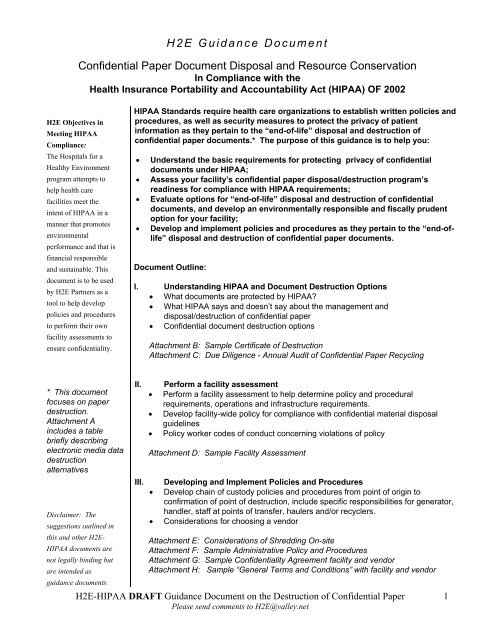
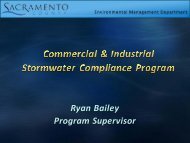

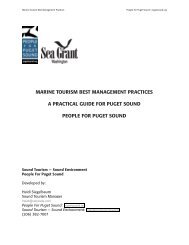
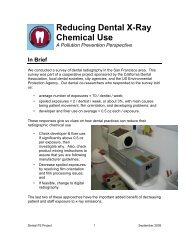
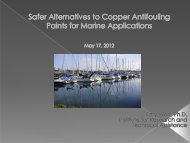
![Dental Amalgam Use [pdf]](https://img.yumpu.com/33828185/1/190x245/dental-amalgam-use-pdf.jpg?quality=85)




